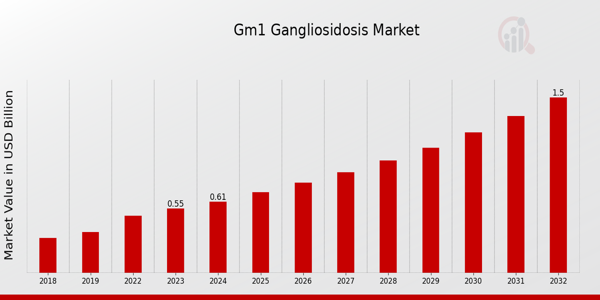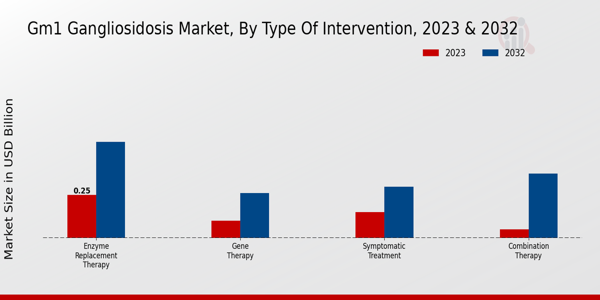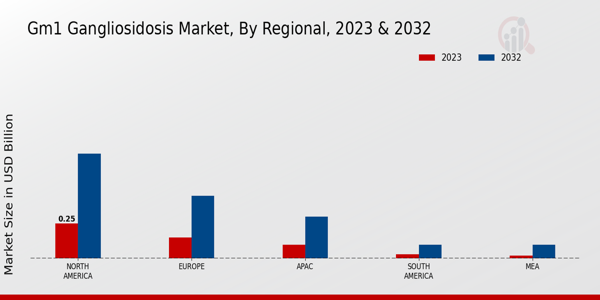GM1 Gangliosidosis Market Overview
As per MRFR analysis, the GM1 Gangliosidosis Market Size was estimated at 0.49 (USD Billion) in 2022. The GM1 Gangliosidosis Market Industry is expected to grow from 0.55(USD Billion) in 2023 to 1.5 (USD Billion) by 2032. The GM1 Gangliosidosis Market CAGR (growth rate) is expected to be around 11.85% during the forecast period (2024 - 2032).
Key GM1 Gangliosidosis Market Trends Highlighted
Several key drivers, including increasing awareness about rare genetic disorders and advancements in genetic research, influence the GM1 Gangliosidosis Market. The growing prevalence of GM1 gangliosidosis and similar lysosomal storage disorders is leading to a heightened demand for effective therapies and treatments. Moreover, the ongoing development of novel therapeutics and potential gene therapies is capturing the attention of pharmaceutical companies and investors, fueling market growth. Regulatory initiatives aimed at expediting drug approvals for orphan diseases are also playing a significant role in shaping this market, presenting opportunities for quicker access to treatment for affected patients.Recent trends indicate a shift towards more personalized medicine approaches in the treatment of GM1 gangliosidosis. Researchers and companies are focusing on developing targeted therapies that address the underlying genetic mechanisms. Collaboration between academic institutions and industry stakeholders is enhancing innovation in treatment options, leading to promising advancements. The market is also witnessing an increase in clinical trials aimed at evaluating the efficacy and safety of new therapies. As awareness continues to spread, there is a greater push towards early diagnosis and intervention, which can improve patient outcomes significantly.There are untapped opportunities within the market that stakeholders can explore. For instance, increasing investment in research and development offers the potential for breakthroughs in treatment methodologies. Additionally, improving access to genetic testing and counseling services can help identify at-risk populations early on, facilitating timely intervention. The integration of technology in healthcare, such as telemedicine and digital health platforms, can enhance patient engagement and adherence to treatment plans. Overall, the dynamic nature of the GM1 Gangliosidosis Market presents numerous avenues for growth while addressing the critical needs of patients affected by this condition.

Source Primary Research, Secondary Research, MRFR Database and Analyst Review
GM1 Gangliosidosis Market Drivers
Rising Incidence of GM1 Gangliosidosis Cases
One of the primary drivers for the GM1 Gangliosidosis Market Industry is the increasing prevalence of GM1 gangliosidosis among populations worldwide. As awareness and understanding of genetic disorders grow, more diagnostic tests are being conducted, leading to a rise in diagnosed cases. This has catalyzed research and development efforts targeting specific therapies for GM1 gangliosidosis, fostering a more robust treatment landscape. Researchers and healthcare professionals are actively seeking innovative solutions to tackle the unmet medical needs associated with this condition.The focus on identifying genetic markers linked to GM1 gangliosidosis has been instrumental in shaping market dynamics, as it paves the way for targeted therapies that could significantly improve patient outcomes. Furthermore, initiatives aimed at improving genetic disorder awareness are contributing to the growing patient population seeking treatment. The development of advanced diagnostic tools and therapies enhances the chances of early detection, which is crucial for managing the disease effectively.Consequently, this trend is encouraging pharmaceutical and biotechnology companies to invest heavily in developing safe and effective treatment options for GM1 gangliosidosis, further propelling market expansion. Looking ahead, as the population ages, the incidence of genetic disorders is expected to increase, ensuring a steady demand for market growth opportunities in the GM1 Gangliosidosis Market Industry.
Advancements in Gene Therapy
Advancements in gene therapy technologies significantly drive the GM1 Gangliosidosis Market Industry. These innovative therapies offer the potential to address the root cause of GM1 gangliosidosis by targeting the genetic mutations responsible for the disorder. Breakthroughs in CRISPR and other gene-editing technologies enable researchers to develop treatments that are not only more effective but also have fewer side effects compared to traditional therapies.As a result, the anticipation surrounding these therapies is invigorating the market due to increasing investments and collaborations among biotech firms, academic institutions, and healthcare providers. The focus on developing more precise and targeted gene therapies is expected to lead to successful clinical trials, advancing the market further.
Increasing Investment in Rare Disease Research
The rising investment in research and development for rare diseases, including GM1 gangliosidosis, is a crucial driver influencing the GM1 Gangliosidosis Market Industry. Governments, non-profit organizations, and private investors are recognizing the necessity to allocate resources toward understanding and treating rare genetic disorders. This trend supports the discovery of novel therapeutic approaches and encourages pharmaceutical companies to enter the market with innovative solutions. The increasing financial backing for rare disease research is facilitating the development of therapies that could transform the lives of affected individuals, thus creating a promising environment for growth in the sector.
GM1 Gangliosidosis Market Segment Insights
GM1 Gangliosidosis Market Type of Intervention Insights
The GM1 Gangliosidosis Market is characterized by its diverse Type of Intervention options, with each method catering to specific therapeutic needs. As of 2023, the market revenue is valued at 0.55 USD Billion, with various interventions playing crucial roles in patient management. The segment of Enzyme Replacement Therapy is notably influential, holding the majority position in the market with a valuation of 0.25 USD Billion in 2023 and projected to reach 0.562 USD Billion by 2032. This dominant position is largely due to the critical role enzymes play in managing GM1 Gangliosidosis symptoms, emphasizing the demand for effective therapeutic solutions.
In addition, Gene Therapy emerges as a significant intervention, representing a growing area of focus in the GM1 Gangliosidosis space. In 2023, Gene Therapy is valued at 0.1 USD Billion, with forecasts suggesting it will rise to 0.262 USD Billion by 2032. The increasing interest in genetic modifications to alleviate the symptoms of the disorder marks this approach as a pivotal component of treatment strategy, offering potential for long-term benefits and disease management. Symptomatic Treatment, valued at 0.15 USD Billion in 2023 and expected to grow to 0.3 USD Billion by 2032, plays an essential role in providing relief from the diverse manifestations of the disease, reinforcing its importance in the therapeutic landscape.
While Combination Therapy, with a present market value of 0.05 USD Billion and a projected increase to 0.375 USD Billion by 2032, represents a collaborative approach combining multiple methods to tackle GM1 Gangliosidosis, its relatively smaller market share reflects the complexities in standardizing such therapies. Nevertheless, Combination Therapy remains significant as it addresses the varied nature of symptoms experienced by patients, thus enhancing overall treatment effectiveness. Together, these intervention strategies indicate a growing understanding and innovation within the GM1 Gangliosidosis Market, driving demand for effective treatment options. The collective insights from the GM1 Gangliosidosis Market segmentation underscore a strong movement towards enhanced treatment methods and signify potential growth driven by advancements in therapeutic approaches. Overall, the market appears to be on an upward trajectory, fueled by a growing recognition of the need for diverse, effective interventions in managing GM1 Gangliosidosis.

Source Primary Research, Secondary Research, MRFR Database and Analyst Review
GM1 Gangliosidosis Market Route of Administration Insights
The GM1 Gangliosidosis Market is evolving significantly, with a strong focus on the Route of Administration which comprises various methods such as Intravenous, Subcutaneous, Oral, and Intrathecal administration. In 2023, the market was valued at 0.55 billion USD, reflecting a profound emphasis on innovative delivery methods for therapeutic intervention. Intravenous administration is crucial as it ensures rapid drug delivery, which is essential for acute management, while Subcutaneous routes enable patient-friendly administration, often enhancing adherence to treatment.The Oral route is also notable, providing a convenient and less invasive means of drug delivery, which is advantageous for patient quality of life. The Intrathecal route, although less common, plays a significant role in targeted therapy, particularly for central nervous system conditions. The GM1 Gangliosidosis Market revenue is projected to undergo substantial growth, driven by advancements in treatment options and increased disease awareness. Challenges such as access to treatments and cost considerations may impact market dynamics, presenting both hurdles and opportunities for stakeholders in the industry as they navigate the landscape of GM1 Gangliosidosis Market data and statistics.
GM1 Gangliosidosis Market Age Group Insights
In 2023, the GM1 Gangliosidosis Market was valued at 0.55 USD Billion, showcasing significant growth potential across various demographics, particularly within the Age Group segmentation. The market is notably influenced by the Pediatric group, which represents a considerable portion of the diagnosed cases, emphasizing the urgent need for targeted therapies and support systems for this vulnerable population. The Adult segment is also gaining traction, as increased awareness and advancements in diagnostic processes allow for improved identification and treatment options for older patients.The market's trajectory reflects the importance of addressing age-specific needs, with distinct therapies tailored to manage symptoms and improve quality of life in both age categories. Growth drivers include rising incidences, enhanced research initiatives, and growing healthcare expenditure, while challenges such as the high cost of treatment and limited availability of effective drugs persist. Nevertheless, opportunities abound in novel treatment development, aimed at managing GM1 Gangliosidosis across all age groups, making the GM1 Gangliosidosis Market a dynamic and evolving landscape.The market growth is also supported by collaborative efforts among healthcare providers and researchers, seeking to expand the GM1 Gangliosidosis Market data and Statistics to inform effective strategies and interventions better.
GM1 Gangliosidosis Market Distribution Channel Insights
In 2023, the GM1 Gangliosidosis Market, valued at 0.55 billion USD, showcases a diverse Distribution Channel landscape essential for delivering treatments. Hospitals play a crucial role, facilitating immediate access to patients needing complex care, especially where specialized treatments for GM1 Gangliosidosis are administered. Specialty Clinics also serve an important function, offering tailored services and expertise in managing rare conditions, thus attracting a significant proportion of patients seeking specialized management. Pharmacies are another vital channel, providing ongoing access to essential medications, which enhances patient adherence and management of therapy.The prominence of these channels reflects market growth driven by increased awareness of GM1 Gangliosidosis and advancements in treatment options. The GM1 Gangliosidosis Market statistics illustrate how these channels collectively support the market’s expansion, although challenges, such as regulatory hurdles and healthcare access disparities, continue to impact growth dynamics. Opportunities remain for expanding pharmaceutical presence and improving healthcare delivery systems, which can significantly influence the GM1 Gangliosidosis Market revenue in the coming years.
GM1 Gangliosidosis Market Regional Insights
The GM1 Gangliosidosis Market, valued at 0.55 USD Billion in 2023, displays significant regional diversity in its segmentation. North America holds a majority share, valued at 0.25 USD Billion, demonstrating strong market growth momentum as it is projected to reach 0.75 USD Billion by 2032. Europe follows, with a valuation of 0.15 USD Billion in 2023 and is expected to expand to 0.45 USD Billion by 2032, highlighting its significant contribution to the GM1 Gangliosidosis Market revenue. In the Asia-Pacific region, the market is valued at 0.1 USD Billion and aims for 0.3 USD Billion as opportunities in emerging markets continue to rise.South America and the Middle East Africa (MEA) represent the smaller portions of the market, valued at 0.03 USD Billion and 0.02 USD Billion respectively in 2023, showing incremental growth to 0.1 USD Billion for both regions by 2032. The varied growth across these regions reflects differences in healthcare infrastructure, awareness levels, and investment in research, illustrating the potential for market expansion driven by increasing demand for innovative therapies and treatment options for GM1 Gangliosidosis.

Source Primary Research, Secondary Research, MRFR Database and Analyst Review
GM1 Gangliosidosis Market Key Players and Competitive Insights
The GM1 Gangliosidosis Market is characterized by a dynamic landscape where numerous players are focused on developing innovative treatment options for this rare genetic disorder. The market is driven by a growing understanding of GM1 gangliosidosis at both molecular and clinical levels, prompting increased investments in research and development. The competitive environment is shaped not only by the emergence of novel therapies but also by regulatory challenges and patient access dynamics. Companies are actively engaging in collaborations, partnerships, and mergers to enhance their market footprint and leverage synergies that can expedite the development and commercialization of their products. The presence of specialized biotech firms alongside well-established pharmaceutical companies creates a competitive atmosphere where innovation and strategic positioning play critical roles in capturing market share.Janssen Pharmaceuticals has established a significant presence in the GM1 Gangliosidosis Market, leveraging its robust research capabilities and a strong commitment to addressing unmet medical needs. The company is recognized for its extensive pipeline focused on neurological disorders, which enhances its potential to develop therapies specifically targeting GM1 gangliosidosis. Janssen's operational strengths include a well-structured distribution network and strong collaborations with healthcare providers and research institutions, facilitating the swift progression of clinical trials. Furthermore, the company’s investment in patient-focused strategies ensures that their product offerings are aligned with the needs of those affected by GM1 gangliosidosis, enabling effective communication and enhancing their brand equity within the rare disease community.Pfizer also plays a vital role in the GM1 Gangliosidosis Market, backed by its extensive experience and historical success in developing innovative therapies. The company’s strengths lie in its financial resources, allowing for substantial investment in research initiatives that can lead to breakthrough treatments for GM1 gangliosidosis. Pfizer has a well-documented history of bringing novel therapies to market, thereby enhancing its credibility and trust within the medical community. The company’s reach, coupled with a strong emphasis on compliance and regulatory affairs, positions it favorably to navigate the complexities of bringing drugs for this rare condition to various markets efficiently. Moreover, Pfizer's commitment to enhancing patient outcomes through education and support programs reflects its dedication to addressing the broader challenges associated with rare diseases, further solidifying its place in the competitive landscape of the GM1 Gangliosidosis Market.
Key Companies in the GM1 Gangliosidosis Market Include
- Janssen Pharmaceuticals
- Pfizer
- Aldevron
- Bayer
- Eisai
- Vertex Pharmaceuticals
- Genzyme
- Amicus Therapeutics
- Horizon Therapeutics
- Sarepta Therapeutics
- AbbVie
- Mallinckrodt Pharmaceuticals
- Novartis
- Bracco Imaging
- Sanofi
GM1 Gangliosidosis Market Industry Developments
Recent developments in the GM1 Gangliosidosis Market indicate increased activity among key players, including Janssen Pharmaceuticals, Pfizer, and Vertex Pharmaceuticals, with ongoing research focusing on innovative treatment options. Notably, Amicus Therapeutics is advancing its gene therapy approach, while Sarepta Therapeutics is gaining attention for its developmental programs aiming to address the underlying genetic causes of GM1 Gangliosidosis. Current affairs highlight an uptick in collaborations, with companies like Genzyme and Bayer exploring synergistic partnerships to enhance drug development pipelines. Furthermore, there have been significant movements in the market, notably a reported acquisition involving Horizon Therapeutics that is expected to broaden its product offerings in rare diseases, which may positively impact its market valuation. The overall market is witnessing a valuation growth due to heightened investments in research and development by major companies such as AbbVie and Novartis. This influx of capital is aimed at accelerating the advancement of therapies and enhancing patient access, crucial for driving future growth in the GM1 Gangliosidosis segment.
GM1 Gangliosidosis Market Segmentation Insights
- GM1 Gangliosidosis Market Type of Intervention Outlook
- Enzyme Replacement Therapy
- Gene Therapy
- Symptomatic Treatment
- Combination Therapy
- GM1 Gangliosidosis Market Route of Administration Outlook
- Intravenous
- Subcutaneous
- Oral
- Intrathecal
- GM1 Gangliosidosis Market Age Group Outlook
- GM1 Gangliosidosis Market Distribution Channel Outlook
- Hospitals
- Specialty Clinics
- Pharmacies
- GM1 Gangliosidosis Market Regional Outlook
- North America
- Europe
- South America
- Asia Pacific
- Middle East and Africa
| Report Attribute/Metric |
Details |
| Market Size 2023 |
USD 116.07 billion |
| Market Size 2024 |
USD 119.06 billion |
| Market Size 2032 |
USD 162.48 billion |
| Compound Annual Growth Rate (CAGR) |
3.86% (2024-2032) |
| Base Year |
2023 |
| Market Forecast Period |
2024-2032 |
| Historical Data |
2018 & 2020 |
| Market Forecast Units |
Value (USD Billion) |
| Report Coverage |
Revenue Forecast, Market Competitive Landscape, Growth Factors, and Trends |
| Segments Covered |
Material, Type, Application, and Region |
| Geographies Covered |
North America, Europe, Asia-Pacific, and the Rest of the World |
| Countries Covered |
The U.S, Canada, Germany, France, the UK, Italy, Spain, China, Japan, India, Australia, South Korea, and Brazil |
| Key Companies Profiled |
Ball Corporation, Crown Holdings Inc, Can pack SA, Silgan Holdings Incorporated, Tubex GmbH, Grief Incorporated, Mauser Packaging Solutions, Ardagh Group, DS Containers Inc, and CCL Containers Inc |
| Key Market Opportunities |
High-quality products and cost-effectiveness |
| Key Market Dynamics |
Increasing consumption of beverages Demand for aerosol cans |
Frequently Asked Questions (FAQ) :
The GM1 Gangliosidosis Market is valued at approximately 0.55 billion USD in 2023.
By 2032, the GM1 Gangliosidosis Market is anticipated to reach around 1.5 billion USD.
The projected CAGR for the GM1 Gangliosidosis Market from 2024 to 2032 is 11.85%.
By 2032, North America is expected to dominate the GM1 Gangliosidosis Market with an estimated value of 0.75 billion USD.
By 2032, Enzyme Replacement Therapy is projected to be valued at 0.562 billion USD, Gene Therapy at 0.262 billion USD, Symptomatic Treatment at 0.3 billion USD, and Combination Therapy at 0.375 billion USD.
Major players in the GM1 Gangliosidosis Market include Janssen Pharmaceuticals, Pfizer, Bayer, Eisai, and Vertex Pharmaceuticals.
The APAC region is projected to reach a market value of 0.3 billion USD in the GM1 Gangliosidosis Market by 2032.
South America is anticipated to contribute approximately 0.1 billion USD to the GM1 Gangliosidosis Market by 2032.
The Symptomatic Treatment segment is expected to grow to approximately 0.3 billion USD by 2032.
Key growth drivers for the market include advances in therapy options, increasing awareness, and rising patient population.

















